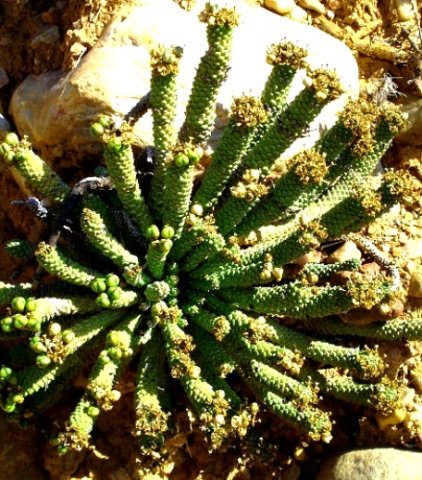Euphorbia colliculina

Author: Ivan Lätti
Photographer: Judd Kirkel Welwitch
Euphorbia colliculina, commonly known in Afrikaans as the Klein Karoo vingerpol (Little Karoo finger tuft), is a stem succulent shrublet reaching about 15 cm in height. The plant consists of a large caudex, an underground water storage tuber showing only its top above-ground with protruding rings of concentric, outward leaning, green, finger-like stems upon it.
The stems are usually leafless, the ephemeral leaves on new stem-top growth being early deciduous. The rhomboid stem tubercles arranged in a repeating, regular pattern of oblique rows, lend the fingers an ornate appearance.
On the plant in picture many of the quite long stems, as these plants grow, still have some functional cyathia as well as green capsules. The bisexual flowers, about 5 mm in diameter, grow in dense clusters at stem-tips in late winter and spring. Each cyathium is surrounded by five yellow bracteoles.
The species distribution is restricted in the southeast of the Western Cape, in a part of the eastern Little Karoo around Calitzdorp, Oudtshoorn and De Rust.
The habitat is karoid scrub and fynbos slopes. The species is deemed endangered in habitat early in the twenty first century, due to habitat loss and degradation caused by ostrich farming, quarrying, brick making, soil erosion and urban expansion (Frandsen, 2017; Vlok and Schutte-Vlok, 2015; iNaturalist; http://redlist.sanbi.org).

